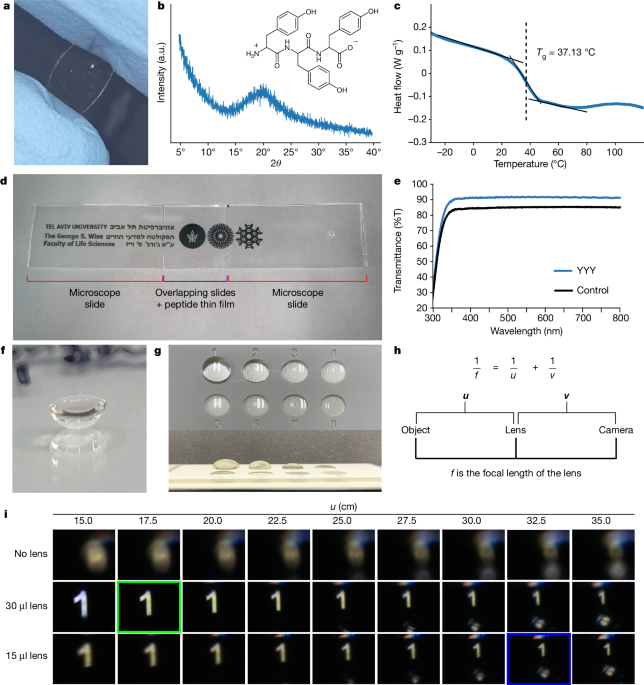insight - Materials Science - # Supramolecular Amorphous Glass Formed by Self-Organizing Aromatic Tripeptide
Discovery of a Self-Healing, Multispectral, and Transparent Adhesive Peptide Glass
Core Concepts
A simple bioorganic peptide glass composed of natural amino acids exhibits a unique combination of properties, including high rigidity, complete self-healing at room temperature, strong adhesiveness, and wide-spectrum transparency from visible to mid-infrared.
Abstract
The content describes the discovery of a supramolecular amorphous glass formed by the spontaneous self-organization of the short aromatic tripeptide YYY, initiated by non-covalent cross-linking with structural water. This system combines often contradictory properties:
- It is highly rigid yet can undergo complete self-healing at room temperature.
- It is an extremely strong adhesive yet is transparent in a wide spectral range from visible to mid-infrared.
- These exceptional characteristics are observed in a simple bioorganic peptide glass composed of natural amino acids.
- The authors present this multi-functional material as potentially highly advantageous for various applications in science and engineering.
- The formation of this glassy material occurs by vitrification, preventing crystallization and promoting an amorphous structure.
- Glass is fundamental in diverse fields of materials science, owing to its unique optical, chemical, and mechanical properties, as well as durability, versatility, and environmental sustainability.
- Engineering a glassy material without compromising its properties is challenging, but the authors have discovered a solution in this self-organizing peptide glass.
Customize Summary
Rewrite with AI
Generate Citations
Translate Source
To Another Language
Generate MindMap
from source content
Visit Source
www.nature.com
A self-healing multispectral transparent adhesive peptide glass - Nature
Stats
The content does not provide any specific numerical data or metrics to support the key logics.
Quotes
"This system uniquely combines often contradictory sets of properties; it is highly rigid yet can undergo complete self-healing at room temperature."
"Moreover, the supramolecular glass is an extremely strong adhesive yet it is transparent in a wide spectral range from visible to mid-infrared."
Key Insights Distilled From
by Gal Finkelst... at www.nature.com 06-12-2024
https://www.nature.com/articles/s41586-024-07408-x
Deeper Inquiries
What are the potential applications of this self-healing, multispectral, and transparent adhesive peptide glass in science and engineering?
The self-healing, multispectral, and transparent adhesive peptide glass has a wide range of potential applications in science and engineering. In the field of materials science, this innovative material could be utilized for creating self-repairing coatings for various surfaces, such as electronic devices, optical components, and even structural materials. The transparency of the glass across a broad spectral range makes it ideal for optical applications, including lenses, windows, and sensors. Its adhesive properties could be harnessed for bonding different materials together, offering a strong and durable connection. Additionally, the ability of the peptide glass to self-heal at room temperature opens up possibilities for applications in environments where maintenance or repair is challenging, such as in space exploration or extreme conditions.
How does the self-organization and non-covalent cross-linking mechanism of the YYY tripeptide contribute to the unique properties of the glass, and could this principle be applied to engineer other types of functional materials?
The self-organization of the YYY tripeptide, along with the non-covalent cross-linking with structural water, plays a crucial role in imparting the unique properties to the glass. The spontaneous assembly of the peptide molecules into an amorphous structure creates a network that provides rigidity to the material. The non-covalent interactions, particularly hydrogen bonding, between the peptide molecules and water molecules act as reversible cross-links, enabling the glass to self-heal. This mechanism allows the material to maintain its structural integrity while being able to repair itself when damaged. The principle of self-organization and non-covalent cross-linking could be applied to engineer other functional materials with similar properties, such as self-healing polymers or adhesives, by designing molecules that can spontaneously organize into a network and form reversible bonds for self-repair.
Given the bioorganic nature of the peptide glass, what are the potential implications or considerations for its environmental impact and sustainability compared to traditional synthetic glass materials?
The bioorganic nature of the peptide glass presents several potential implications for its environmental impact and sustainability compared to traditional synthetic glass materials. As the peptide glass is composed of natural amino acids, it is inherently biodegradable, offering an advantage in terms of environmental impact. The use of bioorganic materials reduces the reliance on fossil fuels and non-renewable resources typically required for synthetic glass production. Additionally, the self-healing property of the peptide glass can prolong its lifespan, reducing the need for frequent replacements and minimizing waste generation. However, considerations must be given to the sourcing of the natural amino acids and the energy-intensive processes involved in peptide synthesis, which could impact the overall sustainability of the material. Further research into optimizing the production methods and sourcing sustainable raw materials could enhance the environmental benefits of the bioorganic peptide glass.
0
